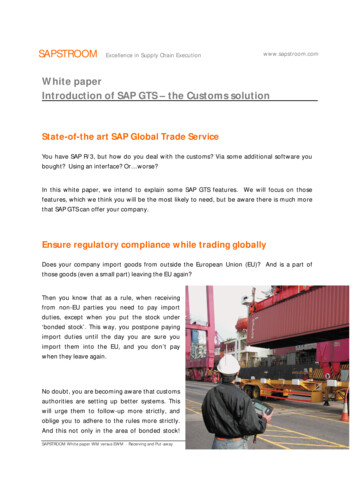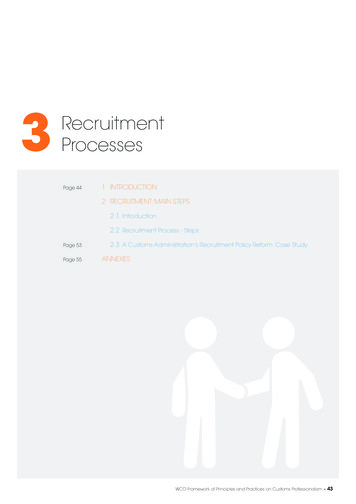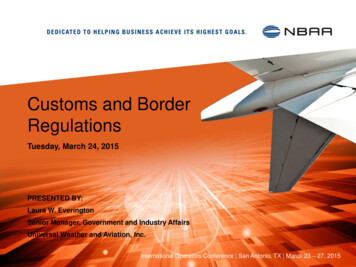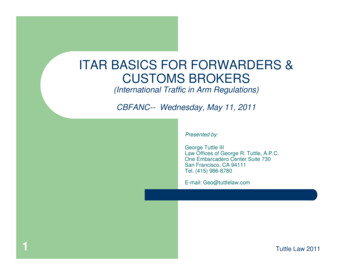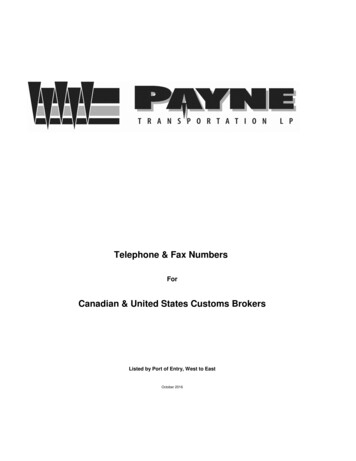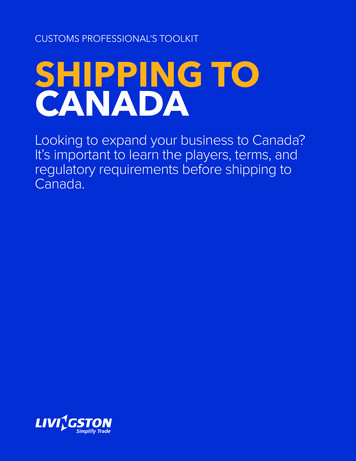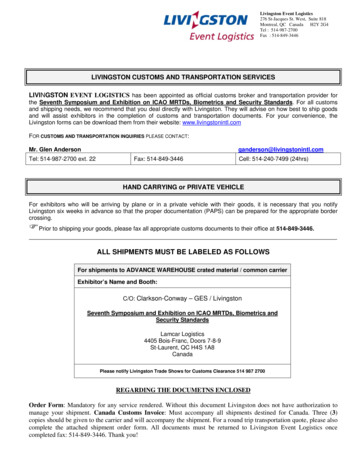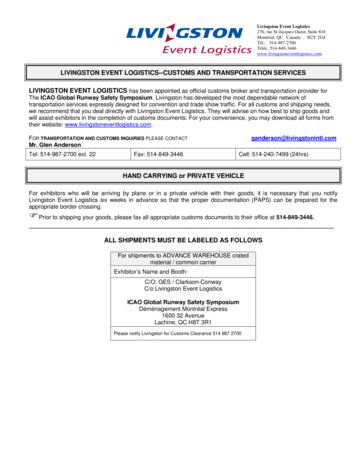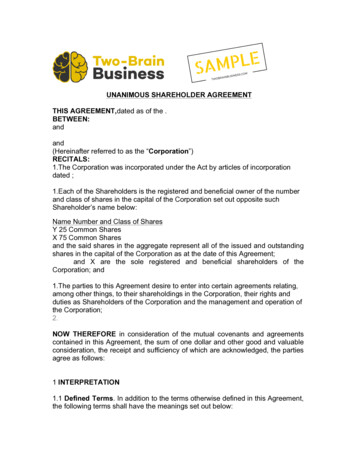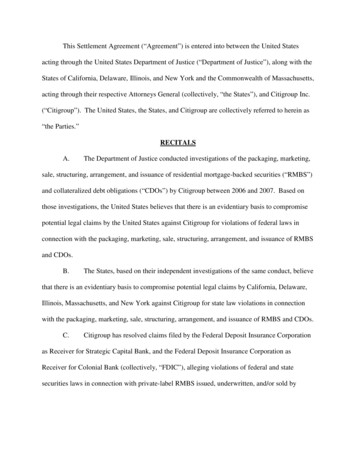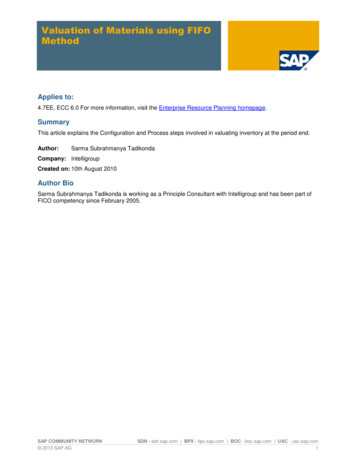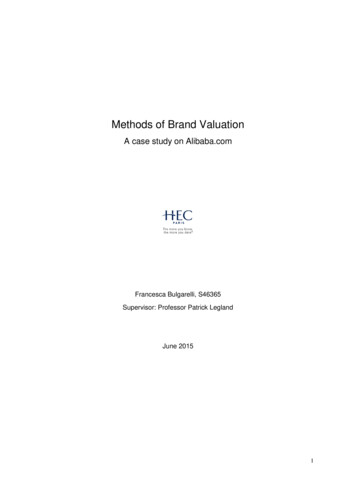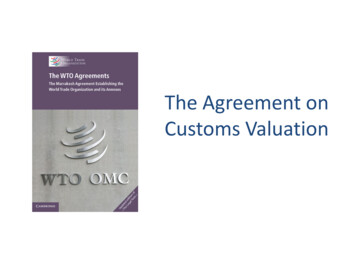
Transcription
The Agreement onCustoms Valuation
Objectives and Structure of thisPresentation Why rules on customs valuation? The WTO Agreement on Customs Valuation Methodologies to value goods
Why Rules on Customs ValuationTo address the need for a fair, Uniform & neutral systemfor the valuation of goods for customs purposes thatprecludes the use of arbitrary or fictitious customsvalues
Why Rules on Customs ValuatationRules on Customs Valuation are necessary to ensure thatwhen applying duty rates to imported goods, the customsservice of each WTO Member determines the value of thegoods in a neutral and uniform manner, since the value ofthe good is the basis on which Customs calculates the dutyrates that are applied to imported goods.It is important for exporters to ensure that market accessopportunities achieved through tariff reductions are notundermined or negated by unwarranted and unreasonableaugmentations in the customs value of goods to whichtariffs are applied.
Why Rules on Customs ValuatationThe use of arbitrary, fictitious and inappropriate“augmentations” by Customs in the valuation of importedgoods when they apply tariffs can result in an unwarranteddoubling or tripling of duties.The result of this inflated valuation is that exporters losethe benefits of the reduced rate of tariffs that have beennegotiated, thereby losing out on its market access.
Customs management and regulation under the GATT General objectiveEnsure that regular customs operations do not hinder unnecessarily international trade are not used to offset concessions that WTO Members haveexchanged between one anotherWhile at the same time recognizing the discretionary autonomythat Customs Authorities must retain in order to fulfil theirobjectives: ensure security, promote product safety, implementlaws and regulations, fight fraud and illegal practices, etc.
Customs management and regulation under the GATT Examples: Art. V – freedom of transit Art. VII – Valuation for Customs Purposes Art. VIII – Fees and formalities connectedwith importation and exportation Art. IX – marks of origin Art. X – publication and administration oftrade regulations
GATT 1947: Articles II:3 and VII Cannot alter valuation method toimpair the value of the concessions. “Actual value“: price of the importedmerchandise, or like merchandise, insales in the ordinary course of tradeunder fully competitive conditions. Customs value shall not be based onvalue of merchandise of nationalorigin, or arbitrary or fictitious values In practice, different systems wereused.
Customs Valuation in the Tokyo Round Considerable differences among systems of customs valuationbetween countries and a lack of precision in the GATTprovisions on customs valuation Unjustified barriers to trade Governments elaborated rules that would provide for agreater uniformity and certainty in the valuation of goods byCustoms In November 1979 a Protocol to the Agreement onImplementation of Article VII was adopted.
Customs Valuation in the Uruguay Round Less than one-third of the GATT contracting partieshad signed the GATT Valuation Agreement. The Uruguay Round negotiations aimed to “improve,clarify, or expand, as appropriate”, the Tokyo RoundCode To make the Valuation Code a multilateral tradeagreement that Members would be obliged toimplement The UR negotiations resulted in the current‘valuation rules’
Current Valuation RulesCustoms Valuation in the Uruguay RoundThe Uruguay Round 1994 resulted in: The Agreement on the Implementation of Article VII ofGATT 1994 – known as the Customs Valuation Agreement The terms of the Tokyo Protocol were incorporated intothe WTO Valuation Agreement Special provisions for developing and least-developedcountries
Current Valuation Rules1.The Customs Valuation Agreement2.Ministerial Decisions related to the CVA3. A Decision regarding cases where Customs have reason todoubt the truth or Accuracy of the Declared Value A Decision on Texts relating to Minimum Values and Importsby Sole Agents, Sole Distributors and Sole ConcessionairesThe Committee on Customs Valuation in 1995 added anotherdecision: The Decision concerning the Interpretation (5) andAdministration (4) of the Agreement (G/VAL/5)
The Customs Valuation Agreement Part I: Rules on customs valuation (Articles 1-17) Part II: Administration, consultations & dispute settlement(Articles 18 and 19) Part III: Special & differential treatment (Article 20) Part IV: Final provisions (Articles 21-24)
General PrinciplesPreamble Primacy of the transaction value method Uniformity in valuation Fairness and neutrality Simple and equitable criteria Consistency with commercial practice
Part I: Content of the Agreement(Articles 1 to 16 PLUS Annexes) Valuation Methods(Art. 1-8) Currency conversion(Art. 9) Confidentiality(Art. 10) Right of Appeal(Art. 11) Publication(Art. 12) Release of Goods(Art. 13) Definitions(Art. 15) Written explanation(Art. 16) Interpretative Notes(Annex I) Technical WCO Committee(Annex II) Developing countries(Annex III)The annexes are an integral part of the CVA (Art. 14)
Part II (Administration, Consultations, and DisputeSettlement): Articles 18-19 Article 18: Establishes two Committees: WTO Valuation Committee – Geneva (policyissues) e.g. implementation issues; softwaredecision Technical Committee on Customs Valuation, WCOin Brussels Article 19: Consultations and disputes
Part III: Special and Differential Treatment (Article 20) When the World Trade Organization was created in 1995,signatories were obliged to accept all GATT instruments,including the WTO Valuation Agreement In recognition of this, special arrangements wereintroduced for developing country Members who mighthave faced difficulties implementing all of the provisionsof the Agreement
Part IV (Final Provisions): Articles 21-24) Article 21: Reservations Article 22: Obligations regarding national legislation Article 23: Review of implementation and operationof the Agreement by the WTO ValuationCommittee Article 24: Responsibilities of WTO and WCOSecretariats
Importance of Customs Value Importation of bananas(10 /Kg): Import duties: « 2 /Kg » (specific) 2 « 20% » (ad valorum) ?20% of .what? If value 5 1 If value 15 3 Rules needed to preserve thevalue of tariff bindings
Authorized Valuation MethodsOrder MUST be followed1 - Transaction value2 - Transaction value of identical goods3 - Transaction value of similar goods4 - Deductive value5 - Computed value6 - “Fall-back “method
Prohibited Valuation Methods(Article 7) Selling price of goods domestically produced Higher of two alternative values Price of goods in the domestic market of the country ofexportation Cost of production other than computed values The price of goods for export to a countryother than the country of importation Minimum customs values Arbitrary and fictitious values
Decision on Reasonable doubts about thetruth of the importer’s declaration Customs may ask importer for additional information/documentation Customs must inform importer of its reasons for doubts Customs must give importer reasonable opportunity torespond Customs must inform importer in writing of final decision Transaction value can be rejected
Notifications on Customs Valuation#12NotificationCopy of nationallegislationChanges in legislationCVA, Art. 22.2Ad hocN/13Checklist of issuesG/VAL/5, B.3One-offN/24Treatment of InterestchargesPara. 2 carrier media(software)G/VAL/5, A.3One-offN/3G/VAL/5, A.4Ad hocN/35Established in: TypeG/VAL/G/VAL/5, B.2One-off N/123
METHOD 1:TRANSACTION VALUE
Article 1.1: Transaction Value“CV of imported goods shallbe the transaction value”Priceactuallypaid orpayableFor thegoodsWhen soldfor exportAdjusted(Art. 8)
Cannot use transaction value if:1. There is no sale2. Restrictions on disposition or use of the goods (Art. 1.1(a))3. Conditions for which a value cannot be determined at time ofimport (Art. 1.1(b))4. Part of the proceeds of subsequent resale, disposal, etc. revertdirectly or indirectly to the seller (Art. 1.1.(c))5. Related parties (only if it influenced the price) (Art. 1.1(d))
Transaction Value:(1) The Price Actually Paid or PayableWhatever amount the buyer agrees to pay the seller to obtain thegoodsCustoms cannot reject an importer’s declared price on thegrounds that:– It is lower than prevailing market prices– It is lower than prices for identical goods in othertransactions– It is a sale at a discount (cash discount, volume discount,trade discount, trade discount, purchase discount)
Transaction Value:(2) for the goods .- Total payment a buyer makes for the goods to, or for the benefit of, theseller, whether directly or indirectly.- Includes all payments required as conditions of the sale of the importedgoods- Often there are payments “in addition to” and “apart” from the price ofthe goods (Art. 8)- May exclude from the calculation: Interest Payments Dividend Payments Post Importation services and costs Advertising/marketing costs Special case: Software (“carrier media decision”)
Transaction Value:(3) when sold for export .- The sale must be one for export to the country of importation.- The seller can be located in any country (incl. importing cont.)- The sale involves an international transfer of goods- Thus, the seller may ship the goods to the country of importationfrom a 3rd country or from no country at all
Transaction Value:Adjustments in Article 8 can be added .1. . only if the charge is not already included in the price of thegoods (e.g. selling commission, cost of containers treated asone; packing) If in doubt, customs may ask the importer to demonstrate thatsale price was inclusive of charge2. Any additions must be based on “objective and quantifiabledata” If customs are not able to quantify the costs, the adjustmentscannot be made. It limits customs’ discretion3. Only the additions provided in Article 8 can be used
Article 8: Required additions to priceExclusive list of additionsAssists (par.1.b)Royalties andlicense feesInternationaltransportcosts (par 2)Containers andPackaging (par.1.a.ii and iii)Commissionsand brokeragefees (par. 1.a.i)Proceeds(par. 1.d)Article 8No otheradditions(par. 4)31
Related Parties:Why does it matter?The concept of “transaction value” relies on competingbusinesses to freely negotiate the fair market value ofimported merchandise. This system works well in a freemarket where businesses maximize their profit.When companies are related, however, this may, or may not,be the case.
Definition of related parties – Art. 15Family Members of the same familyMembers ofsame/affiliatedbusiness Legally recognized partners in business Buyer is the employer of the seller or vice versa Officers or directors of one another’s businessFinancial/Legalcontrol A third person owns, control or holds 5% ormore of the outstanding voting stock of bothbuyer and seller Buyer directly or indirectly controls the seller orvice versa Both the buyer and the seller are controlled by athird person Buyer and seller together directly or indirectlycontrol a third person33
How should Customs proceed?Buyer and Seller arefound to be relatedNot in itself grounds forrejecting the T.V.Main question: Was the priceinfluenced by the relationship?Review:1. Observe the circumstancessurrounding the sale OR2. Measure against test valuesNormally importer’s option
Buyer/Seller Relationship:“Circumstances of the sale”1. Consider the way buyerand seller organize theircommercial relations2. Consider the way inwhich the price in questionwas derivedDid the relationship influence the price?Proof 1:Consistent withnormal industrypracticeProof 2:The same in sales tounrelated partiesProof 3:enough to allowrecovery of costs plusaverage profit
Buyer/Seller Relationship:“Test value”Do these test values “closely approximate” the import price?Country AxYZCountry B
RecapTransaction Value 1. Price paid or payable2. For the goods3. When sold for export 4. AdjustmentsONLY thosein Article 8
D. ALTERNATIVE VALUATIONMETHODS
If customs cannot use the Transaction ValueMethod TV of identical goodsOrder MUST be followed(Article 2)TV of similar goods(Article 3)Deductive value(Article 5)Computed value(Article 6)Fall-back(Article 7)Art. 4
CVA and the WTO Accession ProcessThe aim of the active members of accession Working parties hasbeen to ensure as far as possible that the WTO rules onvaluation are implemented in full from the date on which newMembers accede.The baseline Protocol commitment is therefore:“The representative of [X] confirmed that [it] wouldimplement the provisions of the WTO, including theAgreement on the Implementation of Article VII, concerningcustoms valuation in full from the date of accession to theWTO”.
Elimination of prohibited valuation methodsMembers have been particularly vigilant in ensuring that newMembers conform to certain of these provisions, focusing, forinstance, on the necessity of eliminating and notreintroducing any prohibited valuation methods, such as: the use of minimum values and any system of reference prices or fixed valuation schedulesapplied in lieu of the transaction value.
Notifications under ArticlesThe purpose of the notification requirements as laid down in Article 22.1 issimply to provide transparency to the Committee on the implementation ofthe Customs Valuation Agreement by each Member, and the procedure ispretty straightforward. The notification of Customs Legislation is simply to provide theCommittee with the title and details of a Member's national legislationwhich covers customs valuation, as well as a copy of the relevant texts. Regarding the notification of Replies to the Checklist of Issues, theChecklist of Issues serves as a basis for an initial examination of thenational legislation of each Member by the Commi
1. The Customs Valuation Agreement 2. Ministerial Decisions related to the CVA A Decision regarding cases where Customs have reason to doubt the truth or Accuracy of the Declared Value A Decision on Texts relating to Minimum Values and Imports by Sole Agents, Sole Distributors and Sole Concessionaires 3. The Committee on Customs Valuation in 1995 added another
